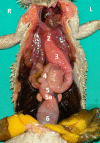Specific anatomy and radiographic illustration of the digestive tract and transit time of two orally administered contrast media in Inland bearded dragons (Pogona vitticeps)
- PMID: 31437183
- PMCID: PMC6705840
- DOI: 10.1371/journal.pone.0221050
Specific anatomy and radiographic illustration of the digestive tract and transit time of two orally administered contrast media in Inland bearded dragons (Pogona vitticeps)
Abstract
The aim of this study was to describe the specific gross and radiographic anatomy of the digestive tract of inland bearded dragons (Pogona vitticeps). Eleven bearded dragon cadavers of both sexes (6 females, 5 males) were dissected to examine, measure, and document the specific gross anatomy of the alimentary canal. Measurements collected from the cadavers included snout-vent length, total length of the alimentary canal, and the lengths of the individual sections of the gastrointestinal tract, including the esophagus, stomach, small intestine, ampulla coli, isthmus coli, rectum, and the distance from the coprodeum to the vent opening. Twenty-two healthy adult bearded dragons (13 females, 9 males) maintained under standardized husbandry conditions underwent a physical examination, blood collection, and whole-body dorsoventral and lateral survey radiographs; these animals were used to provide the radiographic images of the complete digestive tract. For the subsequent contrast passage studies, two different contrast media, barium sulfate (BaSO4, Barilux suspension) and an iodinated ionic radiocontrast agent (Sodium meglumine amidotrizoate [SMAT], Gastrografin), were used. Water-diluted Barilux suspension (dose 9 ml/kg) was administered orally to 5 bearded dragons, while Gastrografin (dose 5ml/kg) was administered orally to 21 bearded dragons. Four animals were used for both contrast media studies, but received a break of four weeks in between. Dorsoventral and laterolateral radiographs were collected at 0 (baseline), 15, 30, and 45 minutes and 1, 2, 3, 4, 5, 6, 8, 10, 12, 24, 30, and 36 hours after each contrast medium was administered. Both contrast media were found to illustrate the alimentary tracts in the adult bearded dragons. Transit time was substantially faster with SMAT, and SMAT illustrated the entire gastrointestinal tract within 36 hours; BaSO4 did not fully illustrate the gastrointestinal tract in 36 hours. These results might serve as a guideline for the interpretation of subsequent contrast studies in this lizard species.
Conflict of interest statement
The authors have declared that no competing interests exist.
Figures




































References
-
- Wright K. Two Common Disorders of Captive Bearded Dragons (Pogona vitticeps): Nutritional Secondary Hyperparathyroidism and Constipation. J Exot Pet Med. 2008;17(4):267–72.
-
- Mitchell MA. Managing the Reptile Patient in the Veterinary Hospital: Establishing a Standards of Care Model for Nontraditional Species. J Exot Pet Med. 2010;19(1 (January)):56–72.
MeSH terms
Substances
LinkOut - more resources
Full Text Sources

